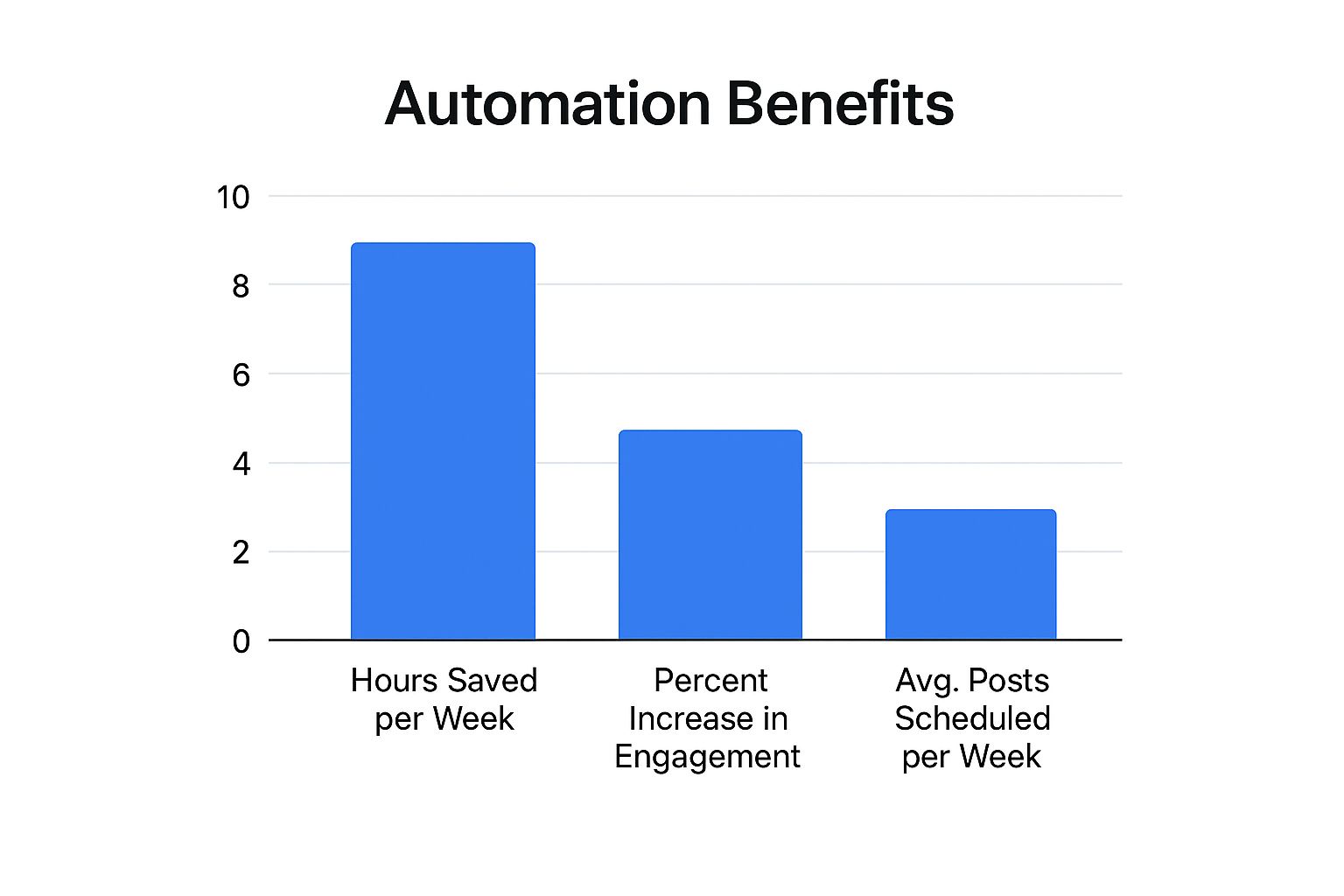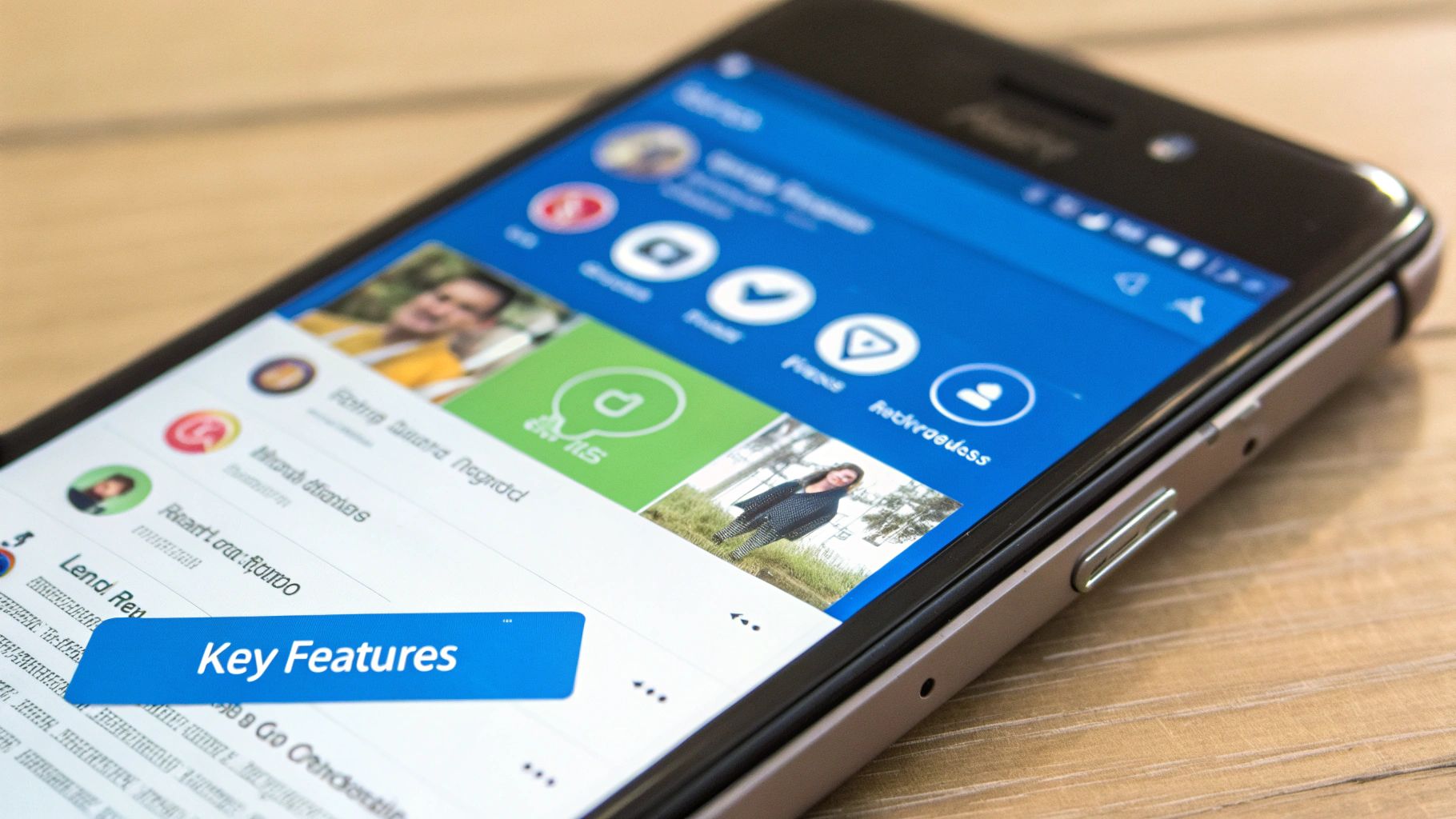Why Smart Marketers Are Going Automated

Maintaining a consistent and engaging social media presence across various platforms is a real challenge for marketers. The demand for constant content creation, combined with the need to adapt posts to each platform's specific audience and format, can easily become overwhelming. This is where social media automation steps in to provide much-needed support.
Think about the effort involved in posting daily across platforms like Instagram, Facebook, Twitter, LinkedIn, and newer networks such as Threads and BlueSky. Each one has its own requirements for image sizes, character limits, and ideal posting times. Without automation, marketers spend a significant amount of time on these repetitive tasks, taking away from valuable time that could be spent on strategic planning and creative content development.
The Crushing Weight of Manual Posting
Manually posting to each platform is not just time-consuming; it's also prone to errors. Missing optimal posting windows can lead to reduced visibility and engagement. Inconsistent posting schedules can also negatively impact brand perception and hinder the development of a loyal following.
Imagine carefully crafting a post, only to discover it's too long for Twitter or the image isn't the right size for Instagram. This constant need to adjust content for different platforms can lead to burnout and limit the ability to effectively scale social media strategies. One growing area is marketing automation with text messages. For more insights, check out this guide from Cartboss on automated text messages.
Automation: Leveling the Playing Field
Automated social media posting offers a solution by allowing marketers to schedule content in advance and distribute it across multiple platforms at once. This frees up time for strategic initiatives like audience engagement, performance analysis, and campaign optimization. Automated social media posting has become increasingly popular for its efficiency and ability to improve engagement.
By 2025, there are projected to be 5.42 billion social media users globally. Businesses are using automation tools to effectively manage their presence across multiple platforms. The U.S. alone saw a growth of 7 million users between January 2024 and January 2025. This underscores the importance of automated strategies for reaching an expanding audience. For more detailed statistics, see this report. This increase in users makes a shift towards automated strategies crucial for maintaining consistent engagement. This allows even smaller businesses to compete with larger ones by using automation to maintain a consistent and engaging social media presence.
The Real Results That Matter To Your Bottom Line
Automated social media posting isn't just about saving time. It's about achieving real, tangible business results. It's a strategic change that helps businesses connect with their audience better, optimize marketing spending, and ultimately, improve profits. This means going beyond simply scheduling posts and adopting a data-driven social media approach.
Measurable Impact: More Than Just Saving Time
One of the most immediate benefits of automation is the significant amount of time saved. This time can then be used for more important activities like strategy development, content creation, and engaging with the audience. Consistent posting, vital for a strong brand presence and audience loyalty, is also ensured through automation. For example, consistent posting keeps your audience engaged and reminds them of your brand, leading to increased brand awareness and recall.
Let's explore the advantages of automated social media posting through a comparison table. This table showcases the efficiency gains, cost savings, and performance enhancements achievable through automation.
| Metric | Manual Management | Automated Management | Improvement |
|---|---|---|---|
| Time Saved (hours/week) | 0 | 8-10 | 8-10 hours |
| Engagement Increase | Variable, often lower | 20-30% | Significant |
| Posts per Week | Limited by available time | 20+ (easily scalable) | Substantial increase |
| Ad Spend Optimization | Requires continuous manual effort | Automated A/B testing and optimization | Reduced costs, improved ROI |
| Targeting Accuracy | Limited by manual research | Data-driven insights for precise targeting | Improved reach and conversion |
This table highlights how automation not only saves time but also substantially boosts engagement and post frequency. This increased engagement leads to greater brand visibility and reach, crucial for business growth.
The following infographic further visualizes these benefits:

As the infographic demonstrates, automation saves considerable time and correlates with a substantial rise in both engagement and posting frequency. This higher engagement translates into increased brand visibility and reach – key factors for driving business growth.
Optimizing Ad Spend and Targeting Accuracy
Automated social media posting also allows for more precise ad targeting and optimized ad spend. Smart marketers are using automation to boost efficiency. For example, using outbound sales automation can significantly improve sales pipelines. Automating tasks like A/B testing and campaign optimization can greatly improve a business's return on investment (ROI). This data-driven approach ensures marketing budgets are used efficiently.
This increased efficiency is fueled by data. Automation platforms like PostOnce provide detailed analytics that offer valuable insights into audience behavior, post performance, and campaign effectiveness. This data helps marketers refine their strategies, target their ideal customers more accurately, and make data-backed decisions that drive results.
AI-Powered Enhancements
The use of AI in social media automation has also led to significant revenue growth for businesses. By using AI tools for ad optimization and content generation, companies have seen engagement rate improvements between 15% and 25%. AI has increased ad targeting efficiency by 25% and makes up 35% of total influencer marketing spending in 2024. Learn more about the impact of AI in social media marketing. These advancements allow brands to quickly adapt and optimize their strategies, resulting in higher ROI and better brand visibility.
Sustainable Growth: Building for the Future
Ultimately, automated social media posting enables businesses to establish a sustainable social media presence that fosters long-term growth. By automating repetitive tasks, optimizing marketing spend, and leveraging data-driven insights, companies can achieve measurable results that positively impact their bottom line. This establishes a foundation for consistent brand building and ensures scalability as the business grows.
Finding Your Perfect Automation Match

With the sheer number of social media automation platforms available, selecting the right one for your specific business needs can be a daunting task. It requires careful consideration of your objectives and finding a platform that aligns with those goals. This section provides a practical framework to help you navigate the options, cut through the marketing hype, and identify the features that truly matter.
Assessing Platform Capabilities
It's important to understand that not all automation platforms offer the same features. Some specialize in scheduling, while others prioritize robust analytics or advanced engagement tools. Successful social media marketing starts with defining your automation objectives. What are you hoping to achieve? Is your primary focus saving time, boosting engagement, or improving your return on investment (ROI)?
Once you've pinpointed your goals, evaluate each platform’s capabilities based on these key areas:
- Scheduling and Publishing: Essential features include bulk scheduling, content queues, and the ability to customize posts for each social media platform. Tools like PostOnce allow you to create content once and distribute it across multiple networks, automatically optimizing the format for each.
- Analytics and Reporting: Tracking key performance indicators (KPIs) is vital. Seek out platforms that offer detailed data on reach, engagement, and conversions, enabling you to measure the effectiveness of your social media strategy.
- Engagement Features: Some platforms offer automated responses, social listening capabilities, and even influencer marketing tools to help you connect with your audience and build relationships.
Integration and Scalability
Seamless integration with your existing tools and workflows is another critical factor. Consider whether the platform integrates with your Customer Relationship Management (CRM) system, analytics dashboards, or other marketing software. Integrating with your CRM, for example, can significantly enhance lead nurturing and overall customer relationship management.
Scalability is also essential. Your automation needs will likely change as your business grows. Choose a platform that can scale accordingly, offering features and pricing plans that adapt to your evolving requirements. Think about factors like the number of social media accounts you can manage, user limits, and the availability of API access.
Key Questions to Ask
To further refine your selection, ask yourself these important questions:
- Which social media platforms do you need to manage? The platform should support all the networks relevant to your business.
- What's your budget? Pricing plans vary significantly, so choose one that aligns with your financial resources.
- What level of support do you need? Look for platforms with comprehensive documentation, helpful tutorials, and responsive customer support.
- What are your team's technical skills? Opt for a user-friendly platform that your team can easily adopt and utilize effectively.
By using this framework and asking the right questions, you can identify the ideal automation platform to empower your social media strategy and drive meaningful results. This allows you to go beyond basic scheduling and truly harness the potential of automation.
Creating Content That Works On Autopilot

Creating engaging content for automated social media posting requires a strategic approach. It's about finding the right balance between the efficiency of automation and the genuine connection of real-time interaction. This means developing a content strategy that reflects your brand's personality while effectively using scheduled posting.
Balancing Scheduled Content and Real-Time Engagement
Automated social media posting offers the convenience of scheduled content delivery. However, maintaining a human touch is paramount. Don't let automation entirely replace real-time engagement. Responding to comments, answering questions, and participating in conversations shows your audience there's a real person behind the brand.
Set aside specific times each day to address comments and messages, even with a primarily scheduled content calendar. This keeps your brand responsive and strengthens connections with your followers.
Content Pillars: The Foundation of Your Automated Strategy
Content pillars are the core themes or topics that underpin your content strategy. They provide structure and ensure consistent messaging across different platforms. These pillars should be broad enough to encompass various content formats, yet specific enough to resonate with your target audience.
For example, a fitness brand might choose content pillars like workout routines, healthy recipes, and motivational tips. This provides a framework for creating a diverse range of content.
Flexible content pillars are also crucial for adapting to different social media platforms. What works on Instagram might not work on LinkedIn. Tailor your message to each platform's audience and format, ensuring your content remains relevant and engaging. For a more in-depth look, check out this guide on How to master automatic social media posting.
Developing an Effective Posting Schedule
An effective posting schedule maximizes reach without overwhelming your followers. Experiment with different posting frequencies and times to find what resonates best with your audience. Analyzing your platform analytics will reveal peak activity times, allowing you to optimize your schedule for maximum visibility.
The type of content also influences optimal posting times. Promotional content might perform better during weekdays, while lifestyle content could be more engaging on weekends. This strategic approach can significantly boost engagement.
Maintaining Brand Voice Consistency
Brand voice is the unique personality that makes your brand recognizable. Maintaining consistency, even with automated posting, is essential. Create a style guide that captures your brand's tone, language, and visual elements. This ensures that all scheduled content aligns with your brand identity.
Streamlined approval workflows are vital for quality control before posts go live. Having a designated person review scheduled content prevents errors and maintains a consistent brand voice, contributing to a professional and cohesive online presence.
Through careful planning, strategic content creation, and a focus on authenticity, automated social media content can effectively engage your audience and drive results, ultimately contributing to a robust online presence that supports your broader business objectives.
Advanced Tactics That Separate The Pros From Beginners
Automated social media posting is much more than just scheduling. True professionals use advanced techniques to maximize their impact and see results far beyond basic scheduling. These tactics involve making automated content smarter, more targeted, and ultimately, more effective.
Intelligent Audience Segmentation
One of the most powerful tactics is intelligent audience segmentation. Instead of sending the same message to your entire audience, divide your followers into specific groups. These groups can be based on demographics, interests, or behavior. For example, a clothing retailer could segment its audience by gender, age, or preferred clothing style.
This allows you to tailor automated messages for each segment. It creates more relevant and engaging content. This personalized approach increases the likelihood of conversions. It also builds stronger relationships with your audience. A targeted approach significantly increases engagement and conversion rates. This is because messages resonate more deeply with specific audience subsets.
Dynamic Content Optimization
Dynamic content optimization takes personalization to the next level. This involves automatically adjusting content based on real-time data and user behavior. Imagine a travel company automatically promoting winter destinations to users who recently searched for ski resorts.
This level of personalization creates a more engaging user experience. It also delivers better results, as your content remains relevant to the individual user. By dynamically adapting to audience preferences, you significantly enhance engagement and drive better campaign outcomes.
Trigger-Based Posting
Trigger-based posting is a powerful automation tactic. It allows you to automatically publish content based on specific events. This can include anything from new product launches to trending news stories. For example, a software company could automatically post a blog article when it releases a new feature.
This keeps your content relevant and timely, capitalizing on current events and user interests. This reactivity enhances engagement and positions your brand as an authority in your industry. For further reach, you might consider cross-posting: How to master social media cross-posting.
Leveraging User-Generated Content
Integrating user-generated content (UGC) into automated workflows can significantly amplify reach and build community. By automatically sharing positive customer reviews or reposting engaging fan content, you demonstrate social proof. This fosters authentic connections, creates a sense of community, and can even reduce your content creation workload.
Data-Driven Refinement: The Key to Continuous Improvement
Finally, successful marketers understand automation is not a set-it-and-forget-it solution. Continuously refining your automated strategy based on analytics data is crucial. Tracking key metrics like engagement, reach, and conversions is important. Use this data to adjust your posting schedule, content, and targeting. This optimizes performance.
The following table provides a breakdown of automation features across different social media platforms. It highlights their strengths in scheduling, analytics, and integration options.
To help illustrate the diverse capabilities across platforms, we've compiled the features of some of the most popular social media management tools.
Social Media Automation Features by Platform Comprehensive breakdown of automation capabilities available across major social media platforms including scheduling, analytics, and integration options
| Platform | Scheduling Features | Analytics Tools | Integration Options | Best For |
|---|---|---|---|---|
| Post scheduling, story scheduling, boosted post scheduling | Page insights, audience insights, ad performance metrics | CRM integrations, email marketing integrations, analytics integrations | Businesses of all sizes | |
| Post scheduling, story scheduling, Reels scheduling | Post insights, profile insights, hashtag analytics | Shopping platform integrations, influencer marketing platforms, analytics integrations | Brands and influencers | |
| Tweet scheduling, thread scheduling, poll scheduling | Tweet analytics, follower insights, hashtag tracking | Social listening tools, news aggregators, analytics integrations | News outlets, individuals, and businesses | |
| Post scheduling, article scheduling, event scheduling | Profile analytics, company page analytics, job analytics | CRM integrations, marketing automation platforms, sales prospecting tools | Professionals and businesses | |
| Pin scheduling, board scheduling, ad scheduling | Pin analytics, board analytics, audience insights | E-commerce platform integrations, content curation tools, analytics integrations | Businesses with visual products or services |
This table summarizes the key automation features offered by popular social media platforms. Choosing the right platform depends on your specific marketing goals and target audience.
This data-driven approach ensures your automation strategy evolves alongside your audience and business objectives. Implementing these advanced techniques allows you to move beyond basic scheduling. It truly unlocks the full potential of automated social media posting.
Tracking What Actually Drives Business Growth
Automated social media posting generates a massive amount of data. Knowing which metrics genuinely correlate with positive business outcomes is essential for ongoing improvement. This goes beyond superficial metrics like likes and follower counts; it’s about understanding what truly impacts your bottom line.
Key Performance Indicators (KPIs) for Success
Successful marketers don't focus solely on likes and shares. Instead, they prioritize key performance indicators (KPIs) that align with specific business objectives. These might include meaningful engagement rates, such as click-through rates on links, or conversion tracking, which measures actions taken after clicking a link (e.g., making a purchase or signing up for a newsletter). For example, tracking how many people click a link in your post to visit your website offers more valuable information than simply the number of likes the post received.
Consider also tracking metrics like website traffic originating from social media, lead generation, and ultimately, sales conversions. These KPIs provide a clearer picture of how your social media efforts are directly contributing to your bottom line. This targeted approach allows you to measure the true impact of your social media strategy.
Setting Up Monitoring Systems for Actionable Insights
Tracking these KPIs requires setting up appropriate monitoring systems. Many automated social media posting tools offer built-in analytics dashboards. You might be interested in: How to master social media automation tools. These dashboards offer a centralized view of your performance across different platforms. Customizing these dashboards to focus on the most relevant KPIs for your business is crucial. This customization prevents you from being overwhelmed by irrelevant data.
For example, if your goal is to drive traffic to your website, prioritize metrics like click-through rates and website referrals from social media. This focused approach lets you quickly identify successful strategies and areas needing improvement, and adapt your strategy based on real-time data.
Interpreting Data and Making Data-Driven Decisions
Collecting data is only the first step. The real value lies in interpreting the data and using those insights to make informed decisions. This involves regularly reviewing your analytics, identifying trends, and adjusting your automation strategy accordingly. For instance, if you find a particular type of content consistently performs well, create more of that content and automate its distribution across multiple platforms.
A/B Testing: Optimizing Your Automated Workflow
Smart companies use A/B testing within their automated workflows. This involves testing different versions of posts – varying headlines, images, or calls to action – to see which performs best. This data-driven approach refines your content strategy over time and identifies the elements that resonate most with your audience. A/B testing provides concrete evidence to support your strategic decisions, making your automation even more effective. By analyzing the results, you can fine-tune your automated posts for optimal performance. This continuous improvement cycle ensures your social media automation delivers increasingly strong results.
Your Step-By-Step Launch Plan
Transitioning to automated social media posting doesn't need to be overwhelming. With a clear plan, you can seamlessly integrate automation into your workflow and start seeing positive results quickly. This guide provides a practical roadmap, covering everything from initial setup to long-term maintenance.
Phase 1: Preparation and Setup
Before automating, build a strong foundation:
-
Define Your Goals: What do you want to achieve? Increased brand awareness? Higher engagement? Clearly defined goals will direct your strategy.
-
Choose Your Platform: Select a platform that aligns with your goals and budget. Consider features, integrations, and user-friendliness. PostOnce is a streamlined option for managing multiple networks.
-
Audit Your Social Media Presence: Evaluate your current activity. Identify top-performing content and analyze audience demographics. This data will inform your automated content strategy.
-
Content Inventory: Compile your existing high-performing content into a library. This serves as the starting point for your automated posting schedule.
Phase 2: Implementation and Training
With the groundwork laid, it's time to implement your plan:
-
Team Training: Make sure your team knows how to use the chosen platform effectively. This maximizes its potential and avoids mistakes.
-
Content Migration: Start moving your content library into the platform. Schedule posts and tailor them for each social media network.
-
Initial Automation Setup: Begin with a manageable posting schedule and gradually increase frequency as you become comfortable.
-
Testing and Refinement: Closely monitor your initial automated posts. Analyze performance and adjust accordingly. A/B testing is helpful at this stage.
Phase 3: Optimization and Maintenance
Once your automation is running smoothly, concentrate on optimization:
-
Advanced Automation Features: Explore advanced features such as audience segmentation or trigger-based posting.
-
Performance Monitoring: Regularly review your analytics to track progress. Use data insights to refine content and posting schedule.
-
Ongoing Maintenance: Keep your system running smoothly with regular checks. This includes content library updates and ensuring integrations function correctly.
-
Stay Adaptive: The social media world constantly changes. Be ready to adjust your automation strategy to stay ahead.
Common Implementation Challenges and How to Avoid Them
Many businesses encounter issues during implementation. Here’s how to avoid common pitfalls:
-
Lack of Clear Goals: Defining objectives from the start is critical. Without specific goals, measuring success is difficult.
-
Inadequate Team Training: Proper training ensures everyone understands the automation platform and its capabilities.
-
Inconsistent Posting Schedule: Maintain a consistent schedule to engage your audience and build brand consistency.
-
Ignoring Analytics: Regular data analysis provides valuable insights for improvement.
-
Neglecting Real-Time Engagement: Automation shouldn't replace human interaction. Dedicate time to engage with your followers in real-time.
By addressing these potential challenges proactively, you can ensure a smooth transition to automated posting and achieve your desired outcomes. This structured method will streamline your social media management and position your brand for lasting success.
Ready to streamline your social media and expand your reach? Start your free trial with PostOnce today!